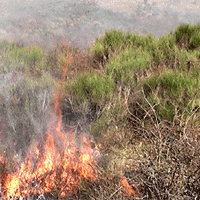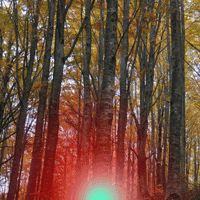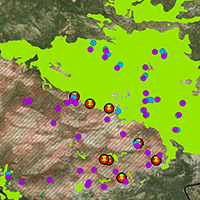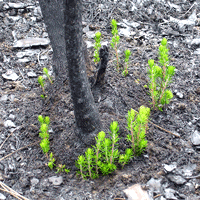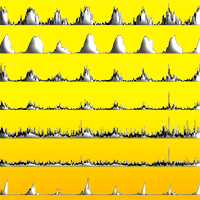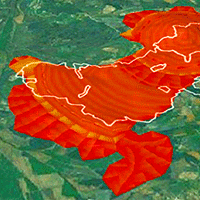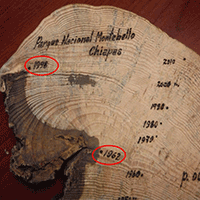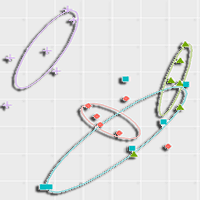
Post-fire recovery of the plant community in Pinus brutia forests: active vs. indirect restoration techniques after salvage logging
Okan Ürker (1), Çagatay Tavsanoglu (1) , Behzat Gürkan (2)
iForest - Biogeosciences and Forestry, Volume 11, Issue 5, Pages 635-642 (2018)
doi: https://doi.org/10.3832/ifor2645-011
Published: Oct 04, 2018 - Copyright © 2018 SISEF
Research Articles
Abstract
Although reforestation is frequently utilized in many Mediterranean Basin countries to restore burned Mediterranean pine woodlands, post-fire recovery of the plant community is often neglected. To compare the post-fire recovery of the plant community following active and indirect post-fire restoration techniques, we studied three post-fire regeneration treatments in a salvage-logged Pinus brutia forest, including two active (plantation and seeding) restoration techniques and one indirect (natural regeneration). An unburned pine stand was also included in the study. We applied the point-intercept method to obtain data on the presence and cover of individual species and functional groups in six replicate one-hectare plots for each treatment. We found no significant differences in plant species richness among post-fire treatments; however, plant community composition and vegetation structure were significantly different between treatments. There was a shift in plant community structure when active restoration techniques were applied, from the woody- and resprouter-dominated plant community of the unburned site to an annual herbaceous- and non-resprouter-dominated one. Our results suggest that active restoration by planting tree saplings in Mediterranean pine forests after a fire may decrease the plant community’s resilience and provide empirical evidence that pine plantation treatments change the plant species composition of these forests. These results have important implications for post-fire management of Mediterranean Basin pine forests.
Keywords
Fire, Mediterranean Pine Forest, Plant Cover, Plant Functional Groups, Post-fire Restoration, Resilience, Species Diversity, Turkish Red Pine
Authors’ Info
Authors’ address
Çagatay Tavsanoglu
Fire Ecology and Seed Research Laboratory, Division of Ecology, Department of Biology, Hacettepe University, 06800 Beytepe, Ankara (Turkey)
Institute of Natural Sciences, Yasar University, Izmir (Turkey)
Corresponding author
Paper Info
Citation
Ürker O, Tavsanoglu Ç, Gürkan B (2018). Post-fire recovery of the plant community in Pinus brutia forests: active vs. indirect restoration techniques after salvage logging. iForest 11: 635-642. - doi: 10.3832/ifor2645-011
Academic Editor
Davide Ascoli
Paper history
Received: Oct 08, 2017
Accepted: Jul 04, 2018
First online: Oct 04, 2018
Publication Date: Oct 31, 2018
Publication Time: 3.07 months
Copyright Information
© SISEF - The Italian Society of Silviculture and Forest Ecology 2018
Open Access
This article is distributed under the terms of the Creative Commons Attribution-Non Commercial 4.0 International (https://creativecommons.org/licenses/by-nc/4.0/), which permits unrestricted use, distribution, and reproduction in any medium, provided you give appropriate credit to the original author(s) and the source, provide a link to the Creative Commons license, and indicate if changes were made.
Web Metrics
Breakdown by View Type
Article Usage
Total Article Views: 51229
(from publication date up to now)
Breakdown by View Type
HTML Page Views: 40561
Abstract Page Views: 4930
PDF Downloads: 4702
Citation/Reference Downloads: 14
XML Downloads: 1022
Web Metrics
Days since publication: 2637
Overall contacts: 51229
Avg. contacts per week: 135.99
Citation Metrics
Article Citations
Article citations are based on data periodically collected from the Clarivate Web of Science web site
(last update: Mar 2025)
Total number of cites (since 2018): 9
Average cites per year: 1.13
Publication Metrics
by Dimensions ©
Articles citing this article
List of the papers citing this article based on CrossRef Cited-by.
References
Flora of Turkey and the East Aegean islands. Edinburgh University Press, Edinburgh, UK, vols. 1-9.
Gscholar
Post-fire management of serotinous pine forests. In: “Post-Fire Management and Restoration of Southern European Forests” (Moreira F, Arianoutsou M, Corona P, De las Heras J eds). Managing Forest Ecosystems, vol. 24, Springer, Dordrecht, Netherlands, pp. 121-150.
CrossRef | Gscholar
Reassessing global change research priorities in Mediterranean terrestrial ecosystems: how far have we come and where do we go from here? Global Ecology and Biogeography 24: 25-43.
CrossRef | Gscholar
Natural regeneration of Pinus brutia Ten. by laying-out of cone-bearing branches on fire-burned areas in Aegean region. Technical Report Series no. 48, Turkish Forest Research Institute, vol. 38, pp. 7-37. [in Turkish with English summary]
Gscholar
Türkiye Bitkileri Listesi (Damarli Bitkiler) [The List of Plant of Turkey (Vascular Plants)]. Flora Arastirmalari Dernegi ve Nezahat Gökyigit Botanik Bahçesi Yayini, Istanbul, Turkey, pp. 1290. [in Turkish]
Gscholar
Factors determining low Mediterranean ecosystems resilience to fire: the case of Pinus halepensis forests. In: Proceedings of the “10th MEDECOS Conference” (Arianoutsou M, Papanastasis VP eds). Rhodes (Greece) 25 Apr - 1 May 2004. Millpress, Rotterdam, Netherlands, pp. 1-12.
Gscholar
Forestry statistics 2008. Publ. no. 384, Turkish Statistical Institute Printing Division, Ankara, Turkey, pp. 65.
Gscholar
Setting the scene for post-fire management. In: “Post-Fire Management and Restoration of Southern European Forests” (Moreira F, Arianoutsou M, Corona P, De las Heras J eds). Managing Forest Ecosystems, vol. 24, Springer, Dordrecht, Netherlands, pp. 1-19.
CrossRef | Gscholar
Structural characteristics of planted and naturally regenerated brutian pine stands. Turkish Journal of Forestry 17: 118-124.
Gscholar
Post-fire vegetation dynamics of Pinus brutia (Turkish Red Pine) forests of Marmaris region. PhD thesis, Hacettepe University, Ankara, Turkey, pp. 106. [in Turkish with English abstract]
Gscholar
Physical and chemical properties of the soils at burned and unburned Pinus brutia Ten. forest sites in the Marmaris region, Turkey. Hacettepe Journal of Biology and Chemistry 38: 71-76.
Gscholar
Post-fire regeneration of Pinus brutia forests. In: “Ecology, Biogeography and Management of Pinus halepensis and P. brutia forest ecosystems in the Mediterranean basin” (Ne’eman G, Trabaud L eds). Backhuys Publishers, Leiden, Netherlands, pp. 291-301.
Gscholar
Forest resilience, biodiversity, and climate change: a synthesis of the biodiversity/resilience/stability relationship in forest ecosystems. Technical Series no. 43, Secretariat of the Convention on Biological Diversity, Montreal, Canada, pp. 67.
Gscholar
Fire ecology and post-fire restoration approaches in Southern European forest types. In: “Post-Fire Management and Restoration of Southern European Forests” (Moreira F, Arianoutsou M, Corona P, De las Heras J eds). Managing Forest Ecosystems, vol. 24, Springer, Dordrecht, Netherlands, pp. 93-119.
CrossRef | Gscholar

